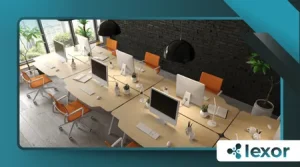How to Create a Smart Office with Modern Gadgets

The modern workplace is evolving at an unprecedented pace, and building a smart office with modern gadgets has shifted from a futuristic concept to a critical competitive advantage.
Gone are the days of static desks and clunky hardware—today’s workspaces demand adaptability, automation, and intelligence.
But what does it truly take to transform a traditional office into a seamless, tech-driven environment?
It’s not just about buying the latest gadgets; it’s about integrating them in a way that enhances productivity, well-being, and security.
A smart office with modern gadgets leverages IoT, AI, and automation to create an intuitive workspace that anticipates needs rather than reacting to them.
According to a 2025 McKinsey report, companies that adopt smart office solutions see a 22% increase in employee efficiency and a 30% reduction in operational costs.
The question is no longer if businesses should upgrade, but how to do it effectively.
The Foundation of a Smart Office: More Than Just Gadgets
A smart office with modern gadgets is only as strong as its weakest integration point.
It’s not enough to install smart lights or a voice assistant—true intelligence comes from how these devices communicate with each other.
Take, for example, a workspace where motion sensors detect employee presence, adjust lighting via Philips Hue, and signal the HVAC system to optimize temperature.
This level of automation doesn’t just save energy; it eliminates distractions, allowing teams to focus on high-value tasks.
++How to Set Up a Smart Home on a Budget
A common mistake is overloading the office with disconnected devices. Instead, focus on interoperability.
Platforms like Apple HomeKit and Samsung SmartThings allow different brands to work together, creating a unified ecosystem rather than a patchwork of gadgets.
Security must also be a priority—smart offices are prime targets for cyber threats.
A zero-trust approach, where every device requires authentication, is no longer optional.
++Best Smart Speakers to Upgrade Your Living Room
Companies like Cisco offer enterprise-grade solutions that segment networks, ensuring that a breach in a smart thermostat doesn’t compromise sensitive data.
Essential Gadgets for a Connected Workspace in 2025

1. Intelligent Lighting Systems That Adapt to Human Rhythms
Lighting is the backbone of a smart office with modern gadgets, influencing mood, focus, and even sleep quality.
Static fluorescent bulbs are obsolete—today’s smart lighting adjusts in real-time.
Nanoleaf’s circadian rhythm system, for instance, mimics natural daylight, reducing eye strain and boosting alertness.
++How VR Is Helping First Responders and Emergency Trainings
But the real innovation lies in predictive lighting.
Some offices now use occupancy sensors combined with AI to learn work patterns, dimming lights in unused areas without manual input.
A study by the American Society of Interior Designers found that dynamic lighting can reduce employee fatigue by up to 18%.
For maximum impact, pair smart bulbs with glare-reducing monitors like the Dell UltraSharp 40, which auto-adjusts brightness based on ambient light.
2. Voice-Activated Assistants for Hands-Free Efficiency
Voice tech has moved beyond setting kitchen timers—it’s now a core productivity tool.
Amazon’s Alexa for Business can schedule meetings, transcribe notes, and even order supplies with a simple command.
Meanwhile, Microsoft’s Copilot integrates with Teams, summarizing emails and drafting responses without breaking workflow.
The key is context-aware AI.
Instead of generic responses, modern assistants pull data from calendars, project management tools, and CRM systems to provide actionable insights.
For example, saying, “What’s my priority today?” could trigger a personalized rundown of deadlines, meetings, and unread Slack messages.
However, privacy concerns remain.
To mitigate risks, opt for enterprise-grade solutions with encrypted voice processing, like Cisco’s Webex Assistant.
3. Wireless Charging Desks and Cable-Free Workspaces
Cluttered cables aren’t just an eyesore—they’re productivity killers.
The latest office designs eliminate cords entirely with Qi-enabled furniture.
The Logitech Powered Desk embeds charging pads into the surface, juicing up phones, earbuds, and even laptops without adapters.
For a more flexible approach, UV-C sanitizing charging stations like those from PhoneSoap keep shared devices germ-free—a must in hybrid work environments.
But wireless power is just the beginning.
Some offices are experimenting with ambient charging, where energy is transmitted through the air via technologies like Ossia’s Cota.
Imagine walking into a meeting room where your phone charges automatically—no pads, no plugs.
4. AI-Powered Air Quality Monitors for Cognitive Performance
Stale air doesn’t just feel stuffy—it dulls thinking.
CO2 levels above 1,000 ppm can decrease cognitive function by 15%, per a Harvard TH Chan School of Public Health study.
Devices like the Awair Element track pollutants, humidity, and VOCs, alerting when ventilation is needed.
The next evolution? Self-regulating air systems.
The Dyson Purifier Cool Autoreact connects to smart vents, closing off areas with poor airflow while filtering contaminants in real-time.
Some offices are even integrating biophilic sensors that adjust conditions based on the number of people in a room, mimicking outdoor air circulation.
Read more: What is a Smart Office?
5. Smart Displays and Holographic Collaboration Tools
Whiteboards are getting a digital makeover.
The Google Jamboard allows teams to sketch ideas remotely, with changes syncing instantly across locations.
But the real game-changer is holographic conferencing.
The Looking Glass Factory’s 3D displays let designers manipulate prototypes in mid-air, while Microsoft Mesh enables avatars to interact in mixed reality.
For everyday use, transparent OLED screens like LG’s Signature OLED T blur the line between physical and digital workspaces.
Imagine reviewing a 3D blueprint on a glass desk that also functions as a touchscreen—this is the future of collaboration.
The Human Factor: Balancing Automation and Intuition
A smart office with modern gadgets fails if employees resist it.
The best systems enhance—not replace—human judgment.
Consider adaptive workspaces.
Steelcase’s Flex Mobile Power system lets employees rearrange charging stations and desks on demand, maintaining flexibility within a smart framework.
Training is equally critical.
A London-based consultancy saw adoption rates soar after running “tech sandbox” sessions where staff tested gadgets in low-stakes scenarios.
The lesson? Involve teams early to demystify automation.
Security: The Non-Negotiable Pillar of Smart Offices
With great connectivity comes great vulnerability.
The 2025 Verizon Data Breach Report found that 43% of IoT breaches originated from office devices.
Beyond encryption, behavioral AI can detect anomalies.
Darktrace’s Antigena, for instance, neutralizes threats by autonomously isolating compromised gadgets.
For smaller setups, hardware firewalls like Bitdefender Box provide robust protection without IT overhead.
Future-Proofing: What’s Next for Smart Offices?
Biometric authentication (think: palm-scanning entry systems) and self-healing networks are on the horizon.
Companies like NTT are piloting AI janitors that rearrange furniture overnight based on usage data.
The line between physical and digital will keep blurring—will your office be ready?
Conclusion: Start Small, Think Big
A smart office with modern gadgets isn’t built overnight.
Begin with high-impact, low-complexity upgrades: smart plugs, air monitors, or a single collaboration screen.
Measure ROI through productivity metrics and employee feedback.
Then scale strategically, always prioritizing usability over novelty.
The future of work is intelligent—but only if technology serves people, not the other way around.
Frequently Asked Questions (FAQs)
Q: How much does it cost to build a smart office?
A: Costs vary widely. A basic setup (smart lights, voice assistants) starts at ~$1,500. Full automation (AI climate control, holographic tools) can exceed $50,000.
Q: Are smart offices secure?
A: Yes, if properly configured. Use VLANs for IoT devices, enforce multi-factor authentication, and regularly update firmware.
Q: Can smart offices work for remote teams?
A: Absolutely. Cloud-based tools like Miro and Zoom Rooms bridge physical and virtual collaboration seamlessly.
Q: What’s the most overlooked smart office gadget?
A: Smart plugs. They’re affordable (~$20 each) and instantly automate any device, from coffee makers to projectors.
Q: How do I convince leadership to invest?
A: Present hard data. Use case studies (like the Berlin startup example above) and pilot a single department first.
Now, over to you—what’s the first gadget you’d introduce in your office?
